Menus
- Real sportswoman
- Discovery
- In the saddle
- In the city
- Motorway and expressways
- Departmental
- Circuit
- Part-cycle
- Braking
- Comfort / Duo
- Consumption
- Conclusion
Real sportswoman
The interest and the growing demand of the so-called emerging countries for small and medium-sized sports cars are revealing previously uncommon models. This is how Kawasaki Ninja 300 and 400, KTM RC 390 and Yamaha YZF R-250 and especially R3 were revealed. Assembled in Indonesia, the latter has made a good track record since 2015, despite ergonomics deemed too roadster. For 2019, the YZF R3 wants to be sportier without becoming radical.

For this, Yamaha has made many changes. 2019 road and track test around Valence.
Discovery
It is finally the A2 license, especially when you see this YZF-R3. Its new aesthetic, elegant and racy, transforms it with an obvious connection with the R6.
It imposes this Yam ‘, with its muscular volumes. Around a central air intake channeling the flow to the radiator, the lights stretch the lines towards marked shoulders, responding to the new design of the 14-liter tank. Flattened by 20 mm, wider by 31.4 units above the knees, the tank leaves more ease and control in sporty riding. Perforated with gills, its frontal covers affirm the character of the model. The side fairings of the machine have a more refined design, even with discreet ailerons. In contrast, as on the 125, the rear loop with discreet volumes gives even more strength to the front of the R3.
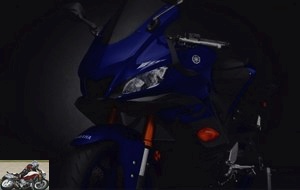
The 169-kilogram Yamaha sports car is built on a tubular steel structure with a diamond-like frame. It supports the 321cc parallel twin, four valves per cylinder driven by a double overhead camshaft, set at 180 °, with forged connecting rods and pistons. Its hyper square bore ratio of 68.0 mm x 44.1 mm ensures good climbs in towers. This allows you to appreciate its power of 42 horses at 10,750 rpm and its 29.6 Nm at 9,000 rpm.

Failing that, a GYTR Performance Kit (HP pistons, camshafts, intake horns, cylinder head gasket) at 900 € coupled with an Akrapovic titanium line (1,200 €) brings the power to 49 hp, reduces the weight and optimizes the motor force. And if you want to participate in WorldSSP300 races, you can even upgrade your machine to a GYTR Cup version. Handlebars, milled rearsets, Ohlins suspension, steering damper, rear loop, data acquisition system, polyester fairing, competition tires and brake pads…. For 6,000 € more than the origin, you go to another world.
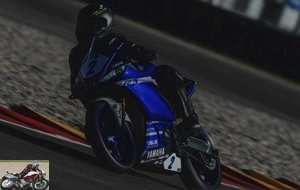
The new YZF-R3 optimizes its cycle part with a new Kayaba 37 mm fork with golden sheaths. More rigid, sliding over 129.5 mm, its damping is adjusted more sporty and not adjustable. It is associated with a new Kayaba mono-shock absorber mounted on rods, adjustable in preload. It manages, on 124.5 mm, a fairly conventional swingarm, but of good quality. Caster angle and wheelbase remain unchanged (25 ° and 1380 mm).
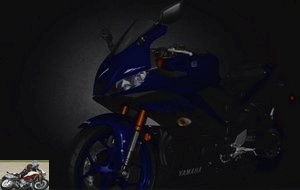
In die-cast aluminum, the 17-inch multi-spoke Y-shaped rims mimic a forged construction. They fit Dunlop GPR300 in 110×70 and 140×70. The front brake caliper is of the axial type. We would have appreciated a more stylish radial ride. Its two pistons bite a 298 mm disc. The retarder opposed to a piston clamps a 220 mm wafer. Finally, the ABS watches over the assembly and selector as brake pedal and plates are made of aluminum.
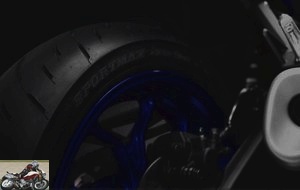
We appreciate a neat finish with two-tone crankcases and passenger footrests bolted (removable) to the frame and openwork triple clamp mimicking that of the R1 (an evolution of the previous model in fact….). We just regret the lack of adjustable lever in spacing, penalizing small hands.
In the saddle
Although claiming more sportiness, the R3 remains accessible with a saddle height of 780 mm. It is even 40 mm less than its sister R-125! But the half-handlebars lower by 22 mm and open more. The pilot’s position is now more forward, for more control in dynamic evolution. Less pleasant, the recoil on the saddle is limited, penalizing a little the older ones.

As on the R-125, the cockpit shows a finish superior to that of the previous vintage. A new LCD instrument panel inspired by the R1 equips the YZF-R3. It includes a central tachometer surmounted by a large, very readable bargraph-type tachometer. Gear indicator, fuel gauge, instantaneous or average consumption, engine temperature, clock and an oil change indicator complete the information. Finally, a shiftlight on the right side optimizes the timing of gear changes..
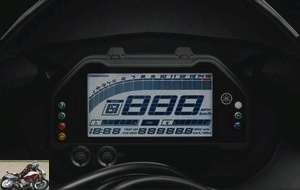
In the city
The twin has a voice. It’s hard to imagine that only 321 cc power this machine. The sound is serious and full, then more metallic in high revs. Particularly voluntary, the twin is also available, picking up without any difficulty at 2,000 revs on 4th gear. Well staged, the box ideally supports the block. Maintained at 4 or 6,000 revolutions, the Yamaha boiler provides very good urban performance.

Agile, the R3 is easily placed in traffic and steers correctly despite a maximum angle of 32 °. Precise, the selection is not the softest on the market, but remains suitable, associated with a flexible clutch control. Finally, the large mirrors return a wide and clear field. The new more sporty ergonomics do not affect comfort in any way, ensuring pleasant journeys on a daily basis. But the dynamism of the twin gives desire for large spaces.
Motorway and expressways
With nearly 190 km / h in peak, the YZF-R3 impresses. And the block in tune is not slow to go from legal to high speed. Of course, we are not glued to the bottom of the saddle, but the constant acceleration makes it easy to hook up to 170 km / h in 5. We then switch to 6 to nibble the last graduations of the tachometer.

The stability is beyond reproach, the protection very correct. At 130 on the last report, the mill turbine at 8,000 revolutions, offering good revivals. At ease, the Yamaha can take you far, as long as you can take it…. For more fun, take the first exit.
Departmental
Surprisingly, the R3 demonstrates an appreciable dynamic homogeneity on the Iberian secondary network. Engine and chassis combine their quality to make this Yam a very efficient little knife. Maintained beyond 7,000 revolutions, the twin effectively propels the machine from turn to turn. Approaching the red zone, 11,000 turns, the shiflight calls to order. Controlled in this way, the twin cylinder gives its best. In 2, we get out of the pins with happiness, the Dunlop GPR300 offering excellent grip, even on very cold (frost….) And sometimes wet asphalt. Caution is still required by these winter frosts and a few slips from the back invite more restraint.

Weight and reduced size associated with a geometry without excess (25 ° caster angle) offer a good compromise between sportiness, reactivity and stability. Rigid, camped on optimized suspensions, the R3 is more precise, incisive in sustained piloting. Its fork remarkably absorbs the defects of the road and the rear shock absorber is progressive. With good ground clearance, the Yamaha hyper sport allows you to ride hard in small corners. And midsize sportswomen might be surprised at the performance of this lightweight athlete. Beware of knockout.
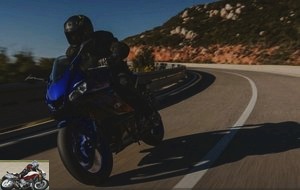
Circuit
On the technical and winding route of the Ribera circuit, the R3 continues to seduce. Here again, the YZF benefits to the full from the 2019 developments. Further ahead, the pilot has better control of the machine, especially when swaying in bends. Especially since the reservoir, wider above the knees, allows you to better wedge your legs. In a straight line, we can also flatten more on the tank.
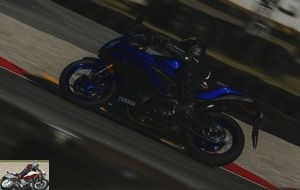
For my part, it is the efficiency of the cycle part that I note, with always an excellent job of the suspensions. In particular, the fork controls its progressive sinking from the start of the race, making it possible to optimize entry into a curve. Agile, the R3 goes from one turn to another very naturally and quickly. On the angle, the trajectory controls are obvious and the machine remains very neutral. Another appreciable point, the front caliper guarantees power and control of decelerations. Like what a simple element, but well made does the trick perfectly.
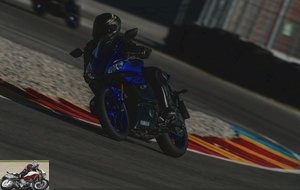
Engine side, it is necessary to maintain the block beyond 8,000 revolutions to benefit from the best of the twin. On this track, we move mainly between third and fifth gear; sometimes both to come out of a pin too closed. Non-excessive rotation of the throttle grip does not break the wrist. And the boiler growls sympathetically, perfectly followed by the Dunlop GPR 300. No problem of grip for these envelopes cashing a half-day of circuit without too important heating.
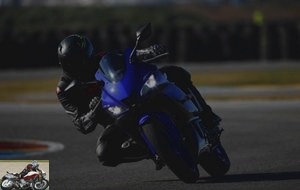
We are also lucky to be able to take the handlebars of a YZF-R3 GYTR Cup of the European Championship, as described above…. Thus prepared, it is yet another motorcycle that we find! Much higher, more inclined forward, with almost unfathomable ground clearance and a boosted twin, the machine is damn efficient. In particular in revival. The mechanics come out more cutting at low revs and the cornering speeds are amazing. Especially in the hands of the students of the Yamaha school. A happy bunch of little ones…. pilots. In short, they are not bad and a little insolent.

But the R3 proves that it really excels on the track and makes it its favorite spot. It makes you want to go and rent it on the Carole circuit.
Part-cycle
Rigid tubular steel frame, quality inverted fork, tuned suspensions…. YZF-R3 combines efficiency and neutrality. Obvious, without excess, the chassis allows you to have fun while keeping control.
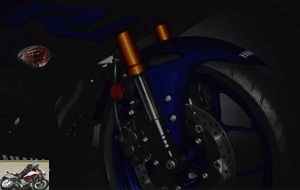
Braking
Simple, the on-board equipment is formidable in efficiency. And good lever control is an asset in urban areas, so as not to be afraid of reflex braking. Even with ABS.
The rear retarder has the same profile, ensuring good guidance in curves on the road.
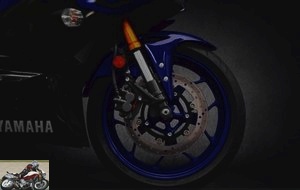
Comfort / Duo
Barely sportier, the R3 is not radical, retaining appreciable comfort on a daily basis. Remove the passenger footrest plates. The machine will be more beautiful and you will save a friend from blaming you.
Consumption
With an average of 3.5 liters / 100 km (computer), the 14 liters of the tank should provide nearly 400 km of autonomy and pleasure..
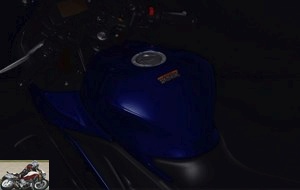
Conclusion
Aesthetics and new cycle parts make the Yamaha YZF-R3 2019 a new machine, more efficient and pleasant to ride. Particularly demonstrative on the road, it provides appreciable dynamic performance. Remains a price close to certain roadsters of 500 or 600 cm3…. A delicate choice for young A2 licensees.
The new opus only increases by 100 €, rising to 5,899 €. Enough to endanger the Kawasaki Ninja 400 priced at 6.199 € and other KTM RC390 at 6.099 €. Hardly more efficient, these machines will have to find the right tone with the new Yamaha.
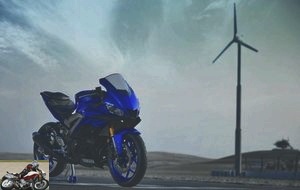
Strong points
- Seductive style
- Evidence of handling
- Demonstrative engine
- Convincing VVA system
- Agility and precision of the chassis
- Ergonomics
- Braking
- Suspensions
Weak points
- A bit high price
The technical sheet of the Yamaha YZF-R3
Test conditions :
- Itinerary: variable surface road, dry and technical track circuit
- Weather: cold and sunny
- Problem encountered: RAS
Test equipment :
- Scorpion Exo-2000 Evo Air Helmet
- Dainese Laguna Seca suit
- Dainese Torque D1 Boots
- Dainese Full Metal D1 Gloves
- Vanucci Nubuck Jacket
- Jean Vanucci Armalith 2.0
Related articles
-
Evil Torgnole power 10 New sporty troublemaker in the successful Yamaha range, the MT10 sets new standards in terms of four-cylinder mechanics. Its…
-
Yamaha MT-07 2021 motorcycle test
Generic anti-depressant Twin CP2, 689 cm3, 73.4 hp, 67 Nm, 184 kg, 7,299 euros The face of bikers in the medium-displacement segment, the Yamaha MT-07…
-
Trace strong and far The impressive commercial success of the Yamaha MTs is a quantified reality: 3,700 MT-09 (including 15% of Street Rallye and Sport…
-
200 hp at 13,500 rpm, 112 N.m at 11,500 rpm, 199 kilos with full fuel, from € 18,499 Is the Crossplane engine an advantage in road use ? Even if the…
-
Pocket cruiser Yamaha and the MT family are pleased to announce the birth to the road of its youngest, the Tracer 700. And yes, more one. And surely…
-
The bête noire of conformism 3 cylinders in line, 889 cm3, 119 hp and 93 Nm, 189 kg, 9,499 euros With its MT-09, Yamaha revolutionized the market for…
-
Yamaha Tracer 9 and Tracer 9 GT motorcycle test
Cross-country sprinters 3 cylinders in line, 889 cm3, 119 hp and 93 Nm, 213 kg full made, from 11,499 euros Road trail, sport-touring, road … the names…
-
Backpacker at heart Twin-cylinder CP2 of 689 cm3, 74 hp and 68 Nm, 204 kg full made, 9,699 euros Stopped at the end of 2016 due to Euro 4 standards, the…
-
R6, Wind and Fire With multiple sporting origins, such is the Yamaha R6, drawing its roots from different family branches of the segment. Thus, at the…
-
Two-Temperaments ! At the end of the 1970s, when motorcycles with large-capacity multicylinder engines weighing a dead donkey have been in vogue for a…
And what if you meet a Geraldine, who falls in pвmoison in front of your posture, this relaxation affirmed and sublimated by this low machine and full of muscles? Well it’s simple: you take her contact on Tinder and you manage afterwards like the big boy (or girl) that you are (or you send her to the nearest Triumph dealer so that she can buy one too).
Very weak point: no feeling of breasts crashing into your back when braking
@Bronco: but not all Geraldines are (alas?) Generously lunged …